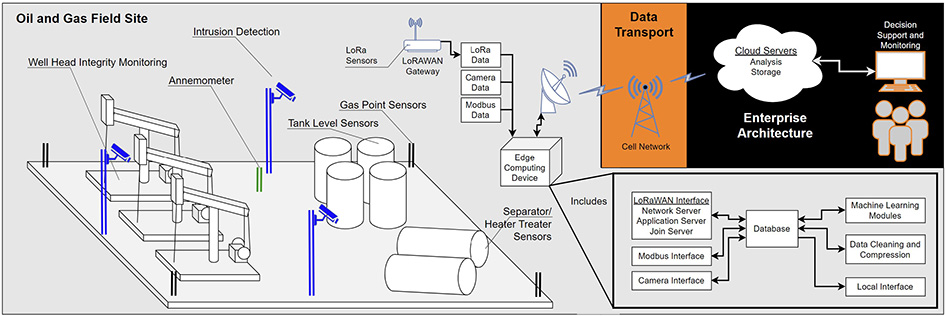Background
This research investigated the performance impact of interfacing multiple sensor data streams and aggregating the data for use by machine learning algorithms on a ruggedized, low power edge computing device. These devices are commonly used in the Industrial Control Systems (ICS) space by supervisory control and data acquisition (SCADA) systems. Edge devices are used in environments where electrical power is minimal and sending data offsite is expensive. Processing machine learning algorithms is computationally intensive and can consume a large quantity of the available computational throughput. A previous project utilizing the same devices saw a 95- 99% Central Processing Unit (CPU) load when running machine learning models alongside video and sensor interfacing. Developing a more efficient method for sensor interfacing and data aggregation will reduce the overall computational load on edge computing devices.
Approach
Based on a current client site, 100 sensor data streams were simulated and used to quantify the computational impact on low power edge computing devices. To reflect a real-world ICS environment, the simulated data interfaces were composed of commonly found control and monitor industrial systems; 50 Long-Range Wide Area Network (LoRaWAN) devices, 40 Modbus devices, and 10 cameras. ARM and x86 computer architectures were tested during this research since they are both used in ICS applications.
Accomplishments
Through tailor-made algorithms and customized filtering, research was successful at minimizing the computational load when simultaneously collecting and aggregating data from the simulated 100 devices. The computational impact of this approach achieved using less than the equivalent of two (2) CPU cores and less than 2.5 GB of memory for both ARM and x64 architectures, for a 40% reduction in CPU and memory utilization. These results were reached by implementing architecture specific drivers on each computing device to maximize computational efficiency. Each interface is deployed in its own container, which allows for individualized configuration. The results of this research enable the evaluation of combining sensor aggregation and machine learning on a single low power edge computing device for industrial internet of things (IoT) applications. Accurately evaluating the feasibility of this approach enables SwRI to propose attractive solutions to industry customers and reduce the risk of this aggressive technical approach. Additionally, while this research focused on industrial devices, the information application can be extended to space, automotive, and transportation low power systems.

Figure 1: Example Site Diagram.
